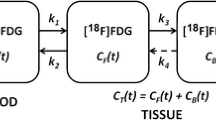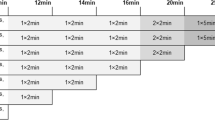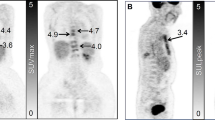Abstract
Purpose
The objective of this study is to determine the reproducibility of static 2-deoxy-2-[18F]fluoro-D-glucose (18F-FDG), 3′-deoxy-3′-[18F]fluorothymidine (18F-FLT), and [18F]-fluoromisonidazole (18F-FMISO) microPET measurements, as well as kinetic parameters returned from analyses of dynamic 18F-FLT and 18F-FMISO data.
Procedures
HER2+ xenografts were established in nude mice. Dynamic data were acquired for 60 min, followed by a repeat injection and second scan 6 h later. Reproducibility was assessed for the percent-injected dose per gram (%ID/g) for each radiotracer, and with kinetic parameters (K 1 –k 4 , K i ) for 18F-FLT and 18F-FMISO.
Results
The value needed to reflect a change in tumor physiology is given by the 95 % confidence interval (CI), which is ±14, ±5, and ±6 % for 18F-FDG (n = 12), 18F-FLT (n = 11), and 18F-FMISO (n = 11) %ID/g, respectively. V d (=K 1 /k 2), k 3, and K FLT are the most reproducible 18F-FLT (n = 9) kinetic parameters, with 95 % CIs of ±18, ±10, and ±18 %, respectively. V d and K FMISO are the most reproducible 18F-FMISO kinetic parameters (n = 7) with 95 % CIs of ±16 and ±14 %, respectively.
Conclusions
Percent-injected dose per gram measurements are reproducible and appropriate for detecting treatment-induced changes. Kinetic parameters have larger threshold values, but are potentially sufficiently reproducible to detect treatment response.






Similar content being viewed by others
References
Wahl RL, Jacene H, Kasamon Y, Lodge MA (2009) From RECIST to PERCIST: evolving considerations for PET response criteria in solid tumors. J Nucl Med 50(Suppl 1):122S–50S
Guarneri V, Barbieri E, Dieci MV, Piacentini F, Conte P (2010) Anti-HER2 neoadjuvant and adjuvant therapies in HER2 positive breast cancer. Cancer Treat Rev 36(Suppl 3):S62–6
Harry VN, Semple SI, Parkin DE, Gilbert FJ (2010) Use of new imaging techniques to predict tumour response to therapy. Lancet Oncol 11:92–102
Dunphy MP, Lewis JS (2009) Radiopharmaceuticals in preclinical and clinical development for monitoring of therapy with PET. J Nucl Med 50(Suppl 1):106S–21S
Hanahan D, Weinberg RA (2011) Hallmarks of cancer: the next generation. Cell 144:646–74
Brepoels L, Stroobants S, Verhoef G et al (2009) (18)F-FDG and (18)F-FLT uptake early after cyclophosphamide and mTOR inhibition in an experimental lymphoma model. J Nucl Med 50:1102–9
Oehler C, O’Donoghue JA, Russell J et al (2011) 18F-fluromisonidazole PET imaging as a biomarker for the response to 5,6-dimethylxanthenone-4-acetic acid in colorectal xenograft tumors. J Nucl Med 52:437–44
Dandekar M, Tseng JR, Gambhir SS (2007) Reproducibility of 18F-FDG microPET studies in mouse tumor xenografts. J Nucl Med 48:602–7
Tseng JR, Dandekar M, Subbarayan M et al (2005) Reproducibility of 3′-deoxy-3′-(18)F-fluorothymidine microPET studies in tumor xenografts in mice. J Nucl Med 46:1851–7
Choi SJ, Kim SY, Kim SJ et al (2009) Reproducibility of the kinetic analysis of 3′-deoxy-3′-[(18)F]fluorothymidine positron emission tomography in mouse tumor models. Nucl Med Biol 36:711–9
Ritter CA, Perez-Torres M, Rinehart C et al (2007) Human breast cancer cells selected for resistance to trastuzumab in vivo overexpress epidermal growth factor receptor and ErbB ligands and remain dependent on the ErbB receptor network. Clin Cancer Res 13:4909–19
Choi SJ, Kim JS, Kim JH et al (2005) [18F]3′-deoxy-3′-fluorothymidine PET for the diagnosis and grading of brain tumors. Eur J Nucl Med Mol Imaging 32:653–9
Tang G, Wang M, Tang X, Gan M, Luo L (2005) Fully automated one-pot synthesis of [18F]fluoromisonidazole. Nucl Med Biol 32:553–8
Tai YC, Ruangma A, Rowland D et al (2005) Performance evaluation of the microPET focus: a third-generation microPET scanner dedicated to animal imaging. J Nucl Med 46:455–63
Fueger BJ, Czernin J, Hildebrandt I et al (2006) Impact of animal handling on the results of 18F-FDG PET studies in mice. J Nucl Med 47:999–1006
Fang YH, Muzic RF Jr (2008) Spillover and partial-volume correction for image-derived input functions for small-animal 18F-FDG PET studies. J Nucl Med 49:606–14
Kim SJ, Lee JS, Im KC et al (2008) Kinetic modeling of 3′-deoxy-3′-18F-fluorothymidine for quantitative cell proliferation imaging in subcutaneous tumor models in mice. J Nucl Med 49:2057–66
Tantawy MN, Peterson TE (2010) Simplified [18F]FDG image-derived input function using the left ventricle, liver, and one venous blood sample. Mol Imaging 9:76–86
Ferl GZ, Zhang X, Wu HM, Kreissl MC, Huang SC (2007) Estimation of the 18F-FDG input function in mice by use of dynamic small-animal PET and minimal blood sample data. J Nucl Med 48:2037–45
Muzi M, Mankoff DA, Grierson JR et al (2005) Kinetic modeling of 3′-deoxy-3′-fluorothymidine in somatic tumors: mathematical studies. J Nucl Med 46:371–80
Burnham KP, Anderson DR (2004) Multimodal inference: understanding AIC and BIC in model selection. Socio Meth Res 33:261–304
Bland JM, Altman DG (1999) Measuring agreement in method comparison studies. Stat Meth Med Res 8:135–60
Galbraith SM, Lodge MA, Taylor NJ et al (2002) Reproducibility of dynamic contrast-enhanced MRI in human muscle and tumours: comparison of quantitative and semi-quantitative analysis. NMR Biomed 15:132–42
Motulsky H (1999) Analyzing data with graphpad prism. GraphPad Software Inc, San Diego
Disselhorst JA, Brom M, Laverman P et al (2010) Image-quality assessment for several positron emitters using the NEMA NU 4-2008 standards in the Siemens Inveon small-animal PET scanner. J Nucl Med 51:610–7
Shields AF, Lawhorn-Crews JM, Briston DA et al (2008) Analysis and reproducibility of 3′-Deoxy-3′-[18F]fluorothymidine positron emission tomography imaging in patients with non-small cell lung cancer. Clin Cancer Res 14:4463–8
Lee SJ, Kang HY, Kim SY et al (2011) Early assessment of tumor response to JAC106, an anti-tubulin agent, by 3′-deoxy-3′-[(1)F]fluorothymidine in preclinical tumor models. Eur J Nucl Med Mol Imaging 38:1436–48
Wang W, Georgi JC, Nehmeh SA et al (2009) Evaluation of a compartmental model for estimating tumor hypoxia via FMISO dynamic PET imaging. Phys Med Biol 54:3083–99
Wang W, Lee NY, Georgi JC et al (2010) Pharmacokinetic analysis of hypoxia (18)F-fluoromisonidazole dynamic PET in head and neck cancer. J Nucl Med 51:37–45
Kersemans V, Hueting R, Cornelissen B et al (2011) Confounding factors arising from the use of anesthesia in preclinical imaging studies of 18F-FMISO as a diagnostic marker of hypoxia. J Nucl Med: Abstract Book Supplement 52:72P–3P
Acknowledgments
We thank the National Institutes of Health for funding through R01 CA138599, P50 CA98131, P30 CA68485, U24 CA126588, P50 CA12832, and 1 S10 RR17858. We thank Clare Osborne for imaging assistance; Jarrod True, Dr. Zoe Yu, M.D., and Carlo Malabanon (Vanderbilt University MMPC) for animal care assistance. We also thank Cammie Rinehart for cell culture and animal assistance.
Conflicts of interest
The authors declare no conflicts of interest.
Author information
Authors and Affiliations
Corresponding author
Rights and permissions
About this article
Cite this article
Whisenant, J.G., Peterson, T.E., Fluckiger, J.U. et al. Reproducibility of Static and Dynamic 18F-FDG, 18F-FLT, and 18F-FMISO MicroPET Studies in a Murine Model of HER2+ Breast Cancer. Mol Imaging Biol 15, 87–96 (2013). https://doi.org/10.1007/s11307-012-0564-0
Published:
Issue Date:
DOI: https://doi.org/10.1007/s11307-012-0564-0




